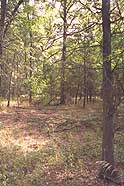
 |
As the name suggests, sand forests grow on sandy soils. River terraces, glacial outwash, and sand dunes are all examples of soils that contain a high percentage of sand. Sand forests on top of dunes or sand ridges are extremely dry (xeric).
Sand forests also occur on sandy slopes and ravines located on older river terraces. These sand forests are rare, support more species of trees, and are not as dry as the forests on dune tops and sand ridges. |
Sand forest and sand savanna
The tree canopy in the sand forest is relatively open, but the trees are not as widely spaced as they are in savannas. Frequently, the boundaries between sand forest and sand savanna are not sharp. One system may exist as an island within the other or an area may fluctuate between sand forest and savanna through time.
Fire
in sand forests and savannas
Both savannas and sand forests are influenced by fire. Some of the sand forests probably burned more frequently prior to European settlement. The dominant trees of the sand forest (typically black oak, blackjack oak, black hickory) respond to fire by resprouting from the roots after the above ground portion of the tree is damaged or destroyed by fire.
Resprouting is responsible for the presence of the many trees with multiple trunks. The trees in a modern sand forest have extensive root systems that may be far older than the above-ground portions of the trees.
Some modern sand forests probably developed when fires became less frequent. European settlers likely contributed to the conversion of some savannas to forest by actively preventing fires (see more in fire suppression). Also, trees invaded areas protected by natural firebreaks, such as exposed sand (a blowout, for example) or a wet depression within the savanna.
Once established, the presence of sand forest actually promoted the forest over the forest/prairie mosaic characteristic of savanna. Ground fires are not sustained in sand forests because the low soil fertility and the heavy shade reduce the understory vegetation and litter ground cover. With only patchy ground cover as fuel, fires are less likely to spread or even burn very long.
Water
and sand forests
Sand forests are droughty. Water percolates quickly through the sand. Moisture at the surface evaporates quickly because of the reduced ground cover. The growth and productivity of individual plants is limited because of the low level of nutrients available in the soil. A low nutrient level also plays a role in the wide spacing of plants in the sand forest. Because the leaves from sand forest trees are low in nutrient content, the rate of decomposition and the cycling of nutrients through the system is slow.
What
trees are found in sand forests?
Characteristic trees of the sand forest include black oak, blackjack oak, and black hickory. These trees are typically stunted and have low, broad crowns. The oaks are often referred to as 'scrub oak' - a term that describes their appearance, and can refer to a number of species of oak.
Despite their appearance, many of these trees have adaptations to drought and low nutrient availability that allow them to survive in an environment where other, less tolerant trees could not survive. Some of these adaptations are
- Blackjack oak (Quercus marilandica) and black oak (Quercus velutina) have tough, heavily cutinized leaves. Cutin is a waxy substance that coats the leaf surface and slows water loss.
- Oak stomata close readily in response to water loss at the surface of the leaf. This means that less water is lost under droughty conditions. (Stomata are small openings in the surface tissues of the leaf. Gases are exchanged through the stomata. These openings are regulated by pairs of special cells, which cause the stomata to open or close in response to the water status of the plant.)
- The physiology of oaks that maintains water balance within the plant adjusts readily to droughty conditions.
- Some oaks are able to maintain higher rates of photosynthesis under droughty conditions than less drought-tolerant trees, and have a distinct advantage in systems that are both nutrient poor and droughty.
- Oaks present in the sand forest conserve nutrients by retaining their leaves into the early winter and withdrawing nutrients from the leaves prior to leaf fall. The leaves are tough and low in major plant nutrients, making them less attractive to herbivores. This 'anti-herbivore' strategy is important. Keeping animals from destroying the leaves is one way to conserve the energy invested in the production of leaves and other tissues.
|
|
Copyright © 2000 Illinois State Museum